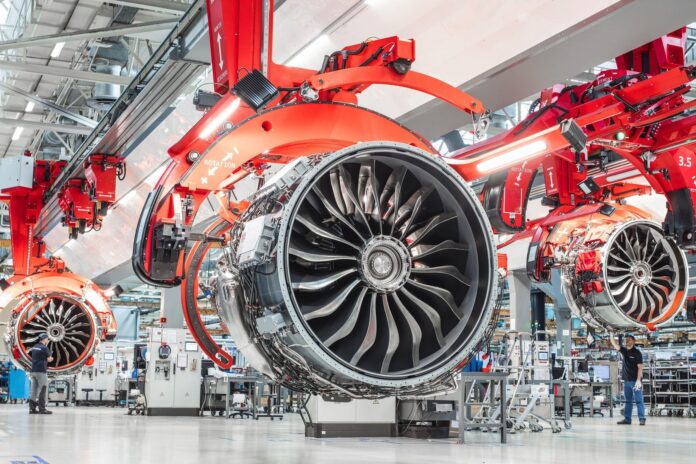Orange’s supply of a non-cellular Bluetooth Low Energy (BLE) indoor tracking system for aerospace manufacturer Safran Aircraft Engines in France, announced in November, is the jumping off point for a wide-ranging conversation about the finer points of selling digital change to the Industry 4.0 market. The gist of it is Orange claims a “unique position” among the telco set by virtue of the fact its Orange Business Services (OBS) unit, author of the Safran deal, is selling more than just cellular. And sometimes, as with Safran, it is not selling cellular at all – just a carefully-mixed bag of other digital-change tech, from the likes of ELA Innovation, Quuppa, and Ubisense.
“OBS is a different beast in the telecoms space; it is a telco and a system integrator (SI), as well,” explains Emmanuel Routier, vice president of Industry 4.0 at OBS, in conversation with Enterprise IoT Insights. “We are a network-native digital services company. That’s our motto; that’s what we do, and what we did here. [The Safran deal] is a very good example, because it is an ecosystem play, where we have put together all the pieces to make it work – and to really push the limits of the technology.”

In charge of ‘verticals and IoT’ through the second half of the 2010s (and old-school M2M before that, through the early 20-teens), it might be argued Routier’s present remit in charge of industrial engagement at OBS is the plum job in telecoms right now. Not because it is Orange, nominally, or even because it is OBS; but because he is bossing Industry 4.0 outreach for a pan-national enterprise division within a multinational mobile operator – with all the tools and all the trade, and none of the hangups of parochial mobile service provision.
In other words, in theory, it can sell whatever it wants to whoever it wants wherever it wants; its sales patter, at least, is not limited by geography or technology, like with national operators looking to sweat expensive infrastructure assets and spectrum licences. As with equivalent SI-style units at the likes of AT&T, Deutsche Telekom, and Verizon, OBS can sell cellular to enterprises anywhere – with its parent’s national spectrum holdings or, as required, via new localised ‘vertical’ spectrum provisions – and bundle-in its own specialist services on top.
In the case of OBS, that means cloud services, cybersecurity applications, and ‘customer experience’ (whatever that means) – alongside its inherent “network-native” knowhow, which includes industrial-geared 5G and low-power wide-area (LPWA) IoT connectivity (LTE-M, and not NB-IoT, in the case of the latter, in line with its parent’s LPWA preferences; non-cellular LoRaWAN is supported alongside, as an alternative for IoT sensors). But as the case with Safran and the conversation with Routier makes clear, these legacy network offers are not a deal breaker for OBS.
Routier explains: “Why did we choose BLE instead of cellular? Because it was the right solution for the customer. Yes, wireless is our domain; we know it well. We offer public and private LPWA solutions. But LTE-M was not right because the power consumption is too high – even though it is lower power than LTE – and because the facility could not rely on the public network. So we needed a dedicated network – not for the facility, but for the use case. Which also meant private LTE or 5G was not appropriate.”
It is the first time 5G has been mentioned, about half way into the discussion about the Safran case – and further evidence that Industry 4.0 strategies in the telco arena should not hinge exclusively on it. OBS is installing private LTE and 5G networks “on a large scale”, says Routier – “all over Europe; in France, Belgium, Romania, Spain”. Just not for Safran in Villaroche and Saint-Quentin-en-Yvelines; not yet, anyway. Routier appears to concede, and also not concede, that a bigger 5G installation might be on the cards at the two Safran production sites.
In response to a direct question about whether Safran will upgrade the twin installations to private 5G, Routier says: “I can’t talk about it; but you just need to read the press announcements – which clearly state that Safran is an innovative enterprise, very state-of-the-art, [adopting] new technologies to improve its performance, and also its products.” So then; Safran is a prime candidate for private 5G, and a BLE-based use case does not preclude, or rob value from, a more ambitious 5G installation – but nothing has been signed, as yet, perhaps.
Ultimately, the initial use cases – for tracking industrial tools and engine parts across the twin production sites in Villaroche and Saint-Quentin-en-Yvelines, located about 50 kilometres southeast of Paris and part of the greater Paris metropolitan area, respectively – justified a BLE-based beaconing solution, rather than a cellular sensing solution, both in terms of the location accuracy and the capital budget, says Routier. But, speaking generally, doubling up on private BLR and 5G makes sense, he explains, especially in remote industrial climes.
“One solution does not go against the other. The BLE antennas, say, taking the signal from the [BLE] tags, need to be connected with cable [to take the data to the cloud] – and a private 5G network would do that job very well, and mean you don’t have to lay fibre in the ground, at potentially great risk for a whole industrial infrastructure. So they are complementary solutions,” he says. Interesting to hear; but, again, we are jumping the gun. Because there is nary a whiff of cellular, let alone 5G, around the Safran deal. It is all BLE, and OBS is only pulling the strings.
This article is continued here.

